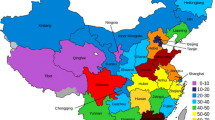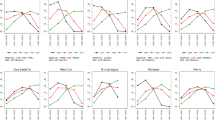Abstract
This article examines the spatial distribution of income and education inequalities and their association in Mexico, focusing on the municipal level. We rely on a small area estimation methodology to construct measures of income inequality that are representative at the municipal level. We also construct variables accounting for education inequality. Based on these variables and on an exploratory spatial analysis, we emphasize a negative association between income and education inequalities, particularly salient among the poor and ethnically diverse municipalities from the southern states such as Oaxaca. Moreover, results from spatial econometrics analyses reveal the existence a U-inverted association between these two types of inequalities. Our results are discussed in relation to education returns, employment opportunities and migration.
Résumé
Cet article analyse la distribution spatiale des inégalités de revenu et d’éducation ainsi que leur association à l’échelle des municipalités du Mexique. Nous mobilisons les méthodes de small area estimation afin de construire des mesures d’inégalité de revenu représentatives à l’échelle municipale. Nous construisons également une mesure d’inégalité d’éducation. A partir de ces variables et d’une analyse spatiale exploratoire, nous mettons en évidence une association négative entre les inégalités de revenu et d’éducation, particulièrement marquée dans les municipalités pauvres et ethniquement fragmentées des états du sud. De plus, l’estimation de modèles d’économétrie spatiale révèle l’existence d’une association en U-inversé entre ces deux types d’inégalités. Nos résultats sont discutés en relation avec les questions de rendements d’éducation, d’opportunités d’emploi et de migration.

Source Authors’ calculations

Source Authors’ calculations

Source Authors’ calculations

Source Authors’ calculations
Similar content being viewed by others
Data availability
The data that support the findings of this study are available on request from the corresponding author.
Notes
As argued by Gasparini (2003, pp. 53–54), the empirical literature “unambiguously suggests that Latin America is the region with the highest levels of inequality in the world, and that this has been true for as long as statistics have been kept”. Focusing more specifically on the Mexican case, Corbacho and Schwartz (2002) explain that income inequality in Mexico is significantly higher than the Latin American average.
According to Barbary (2015), the indigenous populations are primarily located in the most remote areas (which impedes their access to productive resources) and have not benefited from migration dynamics to improve their living conditions.
As explained by Haslett and Jones (2008), in the successful applications of ELL method, the R-squared value of the welfare model tends to be about 0.50 or higher. Our examination of numerous SAE implementations reveals that most of them are based on a welfare model with an adjusted R-squared between 0.5 and 0.7 (e.g. Cuong et al. 2010; World Bank 2015). Moreover, Haslett and Jones (2008) also explain that the variance of the municipal-level component of the error term \({\eta }_{m}\) should be as small as possible. Many SAE applications are based on welfare models with a variance lower than 0.05.
Our calculation of the Gini index is based on the following formula:
$$G=1+\frac{1}{n}-\frac{2}{\stackrel{-}{y}n^{2}}{\sum }_{i=1}^{n}\left(n+1-i\right){y}_{i}$$The class of entropy indices is defined with the following formula:
$$GE\left(\alpha \right)=\frac{1}{\alpha^{2}-\alpha }\left(\frac{1}{n}{\sum }_{i=1}^{n}{\left(\frac{{y}_{i}}{\stackrel{-}{y}}\right)}^{\alpha }-1\right)$$The parameter represents the weight given to distances between incomes in different parts of the income distribution. For lower (higher) values of, GE() is more sensitive to income changes in the lower (upper) tail of the distribution. Using the most common values for (0, 1 and 2), three main indices can be derived: the mean log deviation GE(0), the Theil index GE(1) and half the squared coefficient of variation GE(2).
The Moran’s I statistic is a correlation coefficient measuring the overall spatial autocorrelation of a dataset.
References
Anselin, L. 1995. Local indicators of spatial association—LISA. Geographical Analysis 27 (2): 93–115.
Arslan, A., and J.E. Taylor. 2012. Transforming rural economies: Migration, income generation and inequality in rural Mexico. Journal of Development Studies 48 (8): 1156–1176.
Barbary, O. 2015. Social inequalities and indigenous populations in Mexico: A plural approach. In Social statistics and ethnic diversity, eds. P. Simon et al., 209–228. Cham, Switzerland: IMISCOE Research Series, Springer.
Battistón, D., C. García-Domench, and L. Gasparini. 2014. Could an increase in education raise income inequality? Evidence for Latin America. Latin American Journal of Economics 51 (1): 1–39.
Bebbington, A., J. Escobal, I. Soloaga, and A. Tomaselli. 2016. Poverty, inequality and low social mobility: Territorial traps in Chile, Mexico and Peru. Mexico: RIMISP and Universidad Iberoamericana.
Bourguignon, F., F. Ferreira, and N. Lustig. 2005. The microeconomics of income distribution dynamics in East Asia and Latin America. Washington: World Bank and Oxford University Press.
Budescu, D.V., and M. Budescu. 2012. How to measure diversity when you must. Psychological Methods 17 (2): 215–227.
Campos, R., G. Esquivel, and N. Lustig. 2014. The rise and fall of income inequality in Mexico, 1989–2010. In Falling inequality in Latin America: Policy changes and lessons, ed. A. Cornia, 140–163. Oxford: UNU-WIDER Studies in Development Economics and Oxford University Press.
Carrion-I-Silvestre, J.L., and V. German-Soto. 2007. Stochastic convergence amongst Mexican states. Regional Studies 41 (4): 531–541.
Castelló-Climent, A., and Dómenech, R. (2014) Human capital and income inequality: Some facts and some puzzles. Working Paper n°12/28, BBVA Research Spain.
Chiswick, B.R. 1971. Earnings inequality and economic development. Quarterly Journal of Economics 85: 21–39.
Coady, D., and A. Dizioli. 2018. Income inequality and education revisited: persistence, endogeneity and heterogeneity. Applied Economics 50 (25): 2747–2761.
CONEVAL. 2017. Metodología para la medición de la pobreza en los municipios de México, 2015. Mexico: CONEVAL.
CONEVAL. 2018. Informe de pobreza en los municipios de México 2015. Mexico: CONEVAL.
Corbacho, A., and Schwartz G. (2002). Mexico: Experience with expenditure pro-poor policies. IMF Working Paper, n° 02/12.
Cuong, N.V., T.N. Truong, and R. van der Weide. 2010. Poverty and inequality maps in rural Vietnam: An application of small area estimation. Asian Economic Journal 24 (4): 335–390.
De Gregorio, J., and Lee, J.-W. (2002) Education and income distribution: New evidence from cross-country data.
El Colegio de México. 2018. Inequalities in Mexico 2018. Mexico: El Colegio de México, Red de Estudios sobre Desigualdades.
Elbers, C., J.O. Lanjouw, and P. Lanjouw. 2003. Micro-level estimation of poverty and inequality. Econometrica 71 (1): 355–364.
Elbers, C., Lanjouw, P., and Leite, P.G. (2008) Brazil within Brazil: Testing the poverty map methodology in Minas Gerais. Policy Research Working Paper, n° 4513, The World Bank.
Esposito, L., and A. Villaseñor. 2018. Wealth inequality, educational environment and school enrolment: Evidence from Mexico. Journal of Development Studies 54 (11): 2095–2118.
Esquivel, G. 2011. The dynamics of income inequality in Mexico since NAFTA. Economía 12 (1): 155–179.
Favila-Tello, A., and J.C.L. Navarro-Chávez. 2017. Desigualdad educativa y su relación con la distribución del ingreso en los estados mexicanos. Revista de Investigación Educativa 24: 75–98.
Földvari, P., and B. Leeuwen. 2011. Should less inequality in education lead to more equal income distribution? Education Economics, 19(5), 537–554. Review of Income and Wealth 48 (3): 395–416.
Fujii, T. 2010. Micro-level estimation of child undernutrition indicators in Cambodia. The World Bank Economic Review 24 (3): 520–553.
Gasparini, L. 2003. Different lives: Inequality in Latin America and the Caribbean. In Inequality in Latin America. Breaking with history?, eds. D. De Ferranti, G.E. Perry, F.H.G. Ferreira, and M. Walton. Washington: World Bank.
Gasparini, L., and Lustig, N. 2011. The rise and fall of income inequality in Latin America. In The Oxford Handbook of Latin American Economics, eds. J.A. Ocampo and J. Ros. Oxford: Oxford University Press.
Haslett, S., and Jones, G. (2008). Potential for small area estimation and poverty mapping at constituency and at gewog/town level in Bhutan. Feasability report, Phases 1 and 2.
Knight, J.B., and R.H. Sabot. 1983. Educational expansion and the Kuznets effect. American Economic Review 73 (5): 1132–1136.
Krenzke, T., L. Mohadjer, J. Li, W. van de Kerckhove, L. Li, W. Ren, and H. Adbaru. 2018. Programme for the international assessment of adult competencies. Westat and OECD: Small area estimation research.
Lam, D., Finn, A., and Leibbrandt, M. 2015. Schooling inequality, returns to schooling, and earnings inequality. WIDER Working Paper no. 2015/050, UNU-WIDER.
Lam, D. 2020. Why has income inequality increased while education inequality has decreased in many developing countries? In The political economy of inequality: U.S. and global dimensions, eds. S. Asefa and W.C. Huang. Kalamazoo (MI): W.E. Upjohn Institute for Employment Research.
Lambert, F., and Park, H. 2019 Income inequality and government transfers in Mexico. IMF Working Paper, no. 19/148, IMF.
Legovini, A., Bouillon, C., and Lustig, N. 2005. Can education explain changes in income inequality in Mexico In The microeconomics of income distribution dynamics in East Asia and Latin America, eds., F. Bourguignon, F.H.G. Ferreira and N. Lustig. Washington: World Bank and Oxford University Press.
Lustig, N., L.F. López-Calva, and E. Ortiz-Juarez. 2013. Declining inequality in Latin America in the 2000s: The cases of Argentina, Brazil and Mexico. World Development 44: 129–141.
McKenzie, D., and H. Rapoport. 2007. Migration and education inequality in rural Mexico. Integration and Trade 27: 135–158.
Mendoza-Velázquez, A., D. Ventosa-Santaulària, and V. Germán-Soto. 2019. Mexico’s inter-regional inequality: A convergent process? Empirical Economics 56: 1683–1705.
Mincer, J. 1974. Schooling, experience and earnings. New York: NBER, Columbia University Press.
Modrego, F., and J.A. Berdegué. 2015. A large-scale mapping of territorial development dynamics in Latin America. World Development 73: 11–31.
OECD. 2015. Measuring well-being in Mexican States. Paris: OECD Publishing.
Ram, R. 1984. Population increase, economic growth, educational inequality, and income distribution: Some recent evidence. Journal of Development Economics 14: 419–428.
Rodríguez-Orregia, E. 2005. Regional disparities and determinants of growth in Mexico. Annals of Regional Science 39 (2): 207–220.
Rodríguez-Pose, A., and V. Tselios. 2009. Education and income inequality in the regions of the European Union. Journal of Regional Science 49 (3): 411–437.
Székely Pardo, M., L.F. López-Calva, A. Meléndez Martínez, R. Ramírez, and L. Rodríguez-Chamussy. 2007. Poniendo a la pobreza de ingresos y a la desigualdad en el mapa de México. Economía Mexicana 16 (2): 239–303.
Tarozzi, A., and A. Deaton. 2009. Using census and survey data to estimate poverty and inequality for small areas. The Review of Economics and Statistics 91 (4): 773–792.
Taylor, J.E., Mora, J., Adams, R., and Lopez-Feldman, A. 2008. Remittances, inequality and poverty: Evidence from rural Mexico. In Migration and development within and across borders: Research and policy perspectives on internal and international migration, eds. J. DeWind and J. Holdaway. Geneva and New York: International Organization for Migration and Social Science Research Council.
Whitworth, A. (ed.). 2013. Evaluations and improvements in small area estimation methodologies. National Centre for Research Methods.
Winegarden, C.R. 1979. Schooling and income distribution: Evidence from international data. Economica 46: 83–87.
World Bank. 2010. Poverty maps of Bangladesh. Dhaka: The World Bank.
World Bank. 2015. Mapping poverty in Botswana 2010. The World Bank: Statistics Botswana.
Yúnez, A., Arellano, J., and Méndez, J. 2009. México: Consumo, pobreza y desigualdad a nivel municipal 1990–2005. RIMISP, Working Paper, no. 31.
Author information
Authors and Affiliations
Corresponding author
Additional information
Publisher's Note
Springer Nature remains neutral with regard to jurisdictional claims in published maps and institutional affiliations.
Appendix
Appendix
See Tables 5, 6, 7, 8 and 9; Figs. 5, 6, 7, 8, 9, 10 and 11.
Rights and permissions
About this article
Cite this article
Clément, M., Piaser, L. Geography of Income and Education Inequalities in Mexico: Evidence from Small Area Estimation and Exploratory Spatial Analysis. Eur J Dev Res 34, 703–732 (2022). https://doi.org/10.1057/s41287-021-00386-0
Accepted:
Published:
Issue Date:
DOI: https://doi.org/10.1057/s41287-021-00386-0
Keywords
- Income inequality
- Education inequality
- Ethnic diversity
- Small area estimation
- Exploratory spatial analysis
- Mexico











